



1.jpg)
The tribe to which Buiya folk dance belongs is known as the Digaru Mishmis. The Digaru Mishmi women and men perform the dance. Often performed after a grand feast or in some family gathering, the Buiya dance is a joyful dance that binds the people together. Buiya dance is also performed in multiple festivals like Tazampu, Duiya, and, Tanuya.
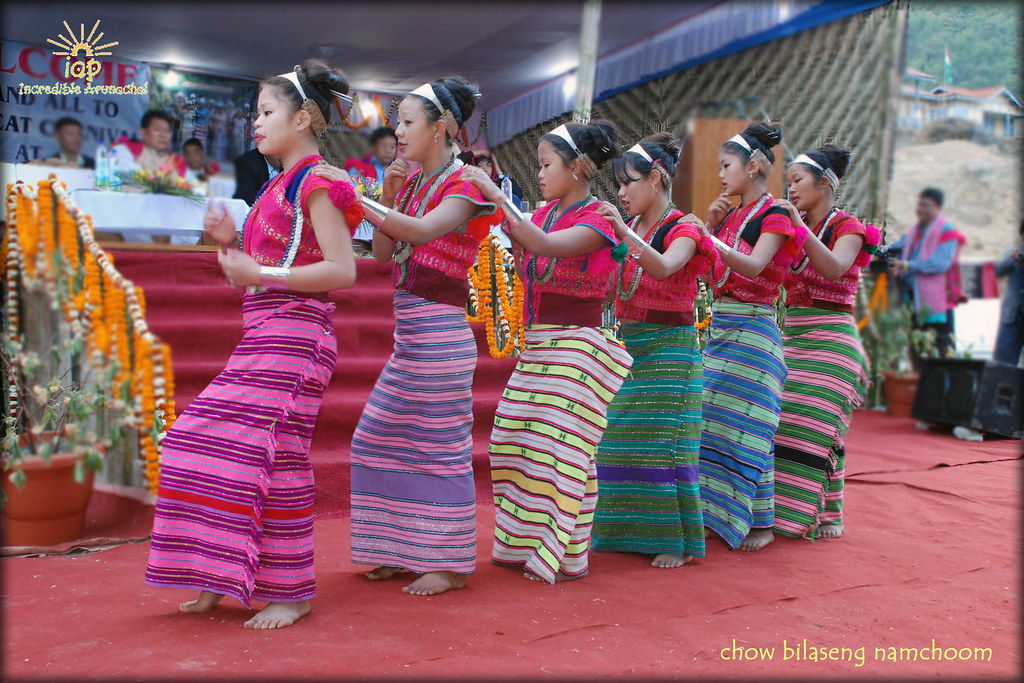
Performance
As the music plays and the gong beats, buiya dancers start moving from the front end of the passage to the rear. The movements are effortless, with the right foot put forward to move ahead by one step. Then the left leg is supported on the left heel with the knee slightly bent. These movements are repeated till the end of the passage is reached.
Another movement involves skipping a step. This is slightly difficult and is usually seen during the performances at festivals. The women make small graceful jumps to move forward. The men, on the other hand, perform higher jumps, which are much faster as compared to the movements of the women.
Instruments
Buiya dance is usually performed along with the beats of the drum and gong. Some performers also play the cymbal. First, it commences with slow rhythms and gradually picks up pace. Sometimes the dance is performed without any music also. Songs may be sung solo or in a chorus.
Attire
Buiya dance does not have any particular dress code. The typical tribal wear is what the performers are seen wearing.
The Chalo dance is part of Arunachal Pradesh’s most awaited festival, called Chalo Loku. This festival is a grand celebration in the state and takes place every year in October and November.
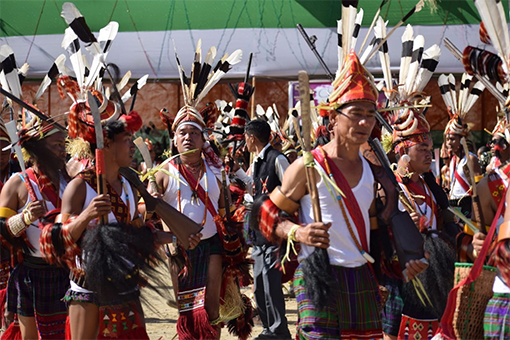
About
It is a celebration of the Nocte tribe. The name “Chalo Loku” translates to paddy cultivation season in English. It is celebrated just before the farmers harvest the paddy. This festival is a way by which the Nocte tribe says goodbye to a past season.
The Chalo dance is open to people of all ages. The performance at the chief’s courtyard requires dancers to be dressed traditionally. The men wear a loincloth in the Indian dhoti style on the bottom. The top is usually bare or adorned with silver or bamboo jewellery.
The headgear is an elaborate one with white feathers attached and many other decorative pieces. The women wear a blouse and cotton skirt that goes up to their knees. They also tie a matching piece of cloth on the waist. Both men and women wear metallic rings, armlets, anklets and earpieces.
Songs and Instruments
The dance is synced with the beats of the drum, and people sing songs.
For better retention: Watch https://youtu.be/Yq-ODz4mDXo

Wancho tribe’s most important festival is known as Oriah. The celebrations take place in the spring months of March and April. The festival begins with prayers, and then music and dance are organised for entertaining the villagers. The Wancho dance is performed at this festival. The dance brings together all members of the tribe which creates a feeling of solidarity.
Costume of Wancho dance
The use of traditional attire is a must for performing the Wancho dance. The men are exposed on the top and wrap a loincloth in the bottom. The cloth is usually a light colour with darker borders and beads for detailing. A band made out of cane goes around the waist. Ivory or cane armbands, bead necklaces, coin necklaces and clusters of red thread in the ears are the accessories donned by the men. The sword they carry has a golden handle enhanced with goat hair. On the head, they wear gear formed from bamboo with hornbill feathers in it.
All male dancers hang a basket of cane around their waists. This basket has decorations of wild boar tail hair, animal skulls, shells and colourful beads. There is a bell attached to the bottom of the basket. As they dance these bells jingle, producing the music to which the dance steps are synced
The women wear the traditional blouse and wrap a skirt around their waist. Necklaces made of coins and beads embellish the look. The arms are decorated with metallic jewellery. On the feet, they wear anklets and toe rings. The women have a headdress or headband with colourful adornments on them.
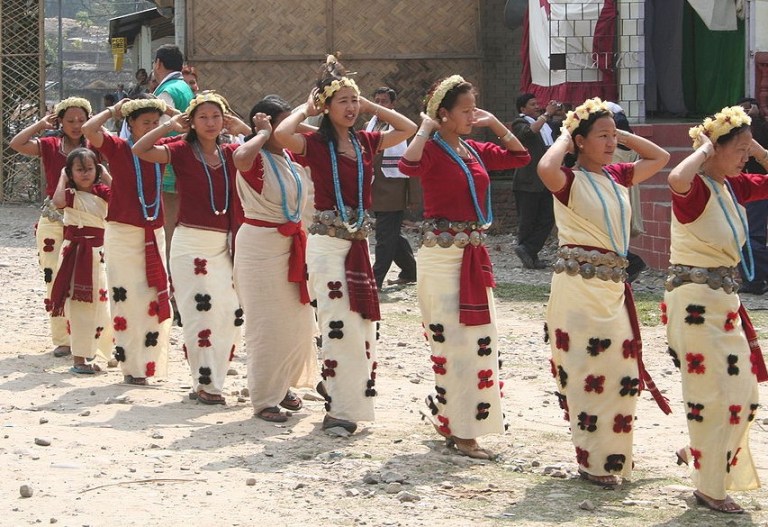
Dance Performance
Both men and women engage in the dance. They usually take turns to perform, accompanied by songs sung by them. The men carry swords on their right hand, which they wield during the dance. The performance begins with the men singing and dancing. They also make a peculiar thrusting movement with the sword, which is unique. Once the men end their song and dance, the women come in and start a song. They match steps to the song and the song is a reply to what the men conveyed through their song. This process is repeated for various times.
The men make a round configuration and move around doing the dance moves. The women on the other hand form two straight lines, facing each other.
For Better Retention: Watch https://youtu.be/cBhvvsiry6g

Another popular folk dance of Arunachal Pradesh, Pasi Kongki is a celebration of a tribe called Adi. The dance is performed to narrate the social work that the Pasi has done. It is indeed a unique representation of the rich culture that defines the Adi tribe of Arunachal Pradesh.
The dance is performed to the tune of a song sung by the locals. The song is called Aabang.
The dance depicts how the Pasi would go to the plains to fetch iron and other essentials from the market. They would march on foot, crossing the dangerous hilly terrain. The iron procured from the plains was then brought to the smith known as the Pasi Mide. The smith’s job was to transform the raw iron into sharp Daos or knives of various shapes and sizes.
Through the Pasi Kongki dance, the tribe pays tribute to those great men who risk their lives to fetch items for the villagers.
Dance Formation and Costume
Both men and women can perform the dance. The dancers form a straight line and match their steps to the rhythm of the drum. The men have a much more energetic movement when compared to women.
The costumes worn by the dancers make the performance even more picturesque. The men wear a white shirt matched with a white loincloth on the bottom. A long sleeveless jacket is worn on top that goes up to the knees. The headgear is adorned with many black and white feathers. They wear some jewelry around their neck and hands. Some also wear silver rings around the ankles. All the men carry a sword in their hands while dancing.
The women look gorgeous costumed in a blouse and a skirt going up to their ankles. Long gold and silver chains adorn their necks and chests. The head is covered with a conical-shaped hat, draped in colorful cloth, and a trail hanging in the back. They also wear spiral-shaped jewelry on their legs that chime as they move around.
For Better Retention: Watch https://youtu.be/0h3y53e6fxw
Ponung Dance belongs to the Adi tribe. Ponung dance is an important religious celebration for the Adi tribe. The Ponung folk dance is performed to pray to god just before the harvest period.
The dancing young girls and women form a circle. The Ponung dancers place their hands on each other’s shoulders as they perform the steps. In some cases, they hold hands to form the circle. There is only one male who takes part in the show. This man is known as the Miri. He stands in the centre of the circle formed by the women and sings a folk song, which is the only music to which the women dance. The song narrates information about the origin of the crops they harvest, the history of the Adis, and much more.
The Miri also plays a musical instrument called the Yoksha. It is shaped in the form of a sword and is shaken by the Miri as he sings along. Discs of iron are loosely attached to this sword-like Yoksha, which produces a rattling sound. The Ponung dance steps are simple. The women move in the circle in rhythm.
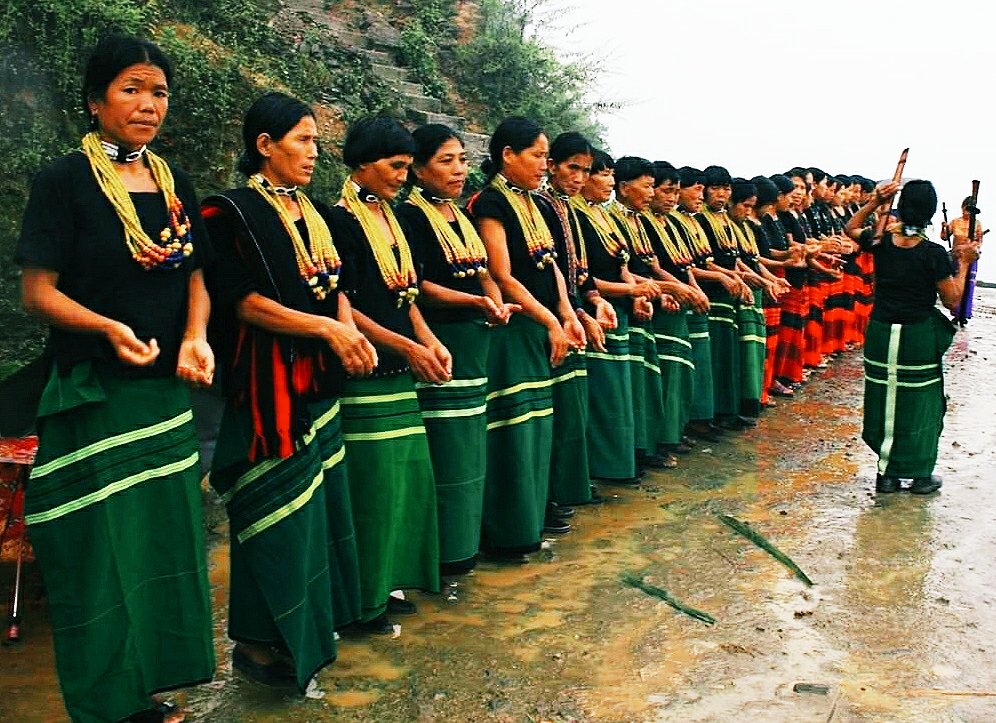
Costume
In the Ponung folk dance, the women dress up in traditional attire. On top, they wear a black shirt or blouse. On the bottom, a skirt is wrapped around the waist, and it goes down up to the ankles. The skirts usually have broad horizontal stripes matching the blouse. On the head, these women wear a conical hat cloaked in a cloth that trails behind.
To complete the look, the women adorn themselves with traditional style jewelry. Long chains attached with small circular sequences are worn around the neck. These are paired with other colorful neckpieces of various other metals.
For Better retention: Watch: https://youtu.be/0uw7PM1sf-g
Galo tribe of Arunachal Pradesh is known for its popular Popir dance. This tribe celebrates several festivals around the year.
Popir dance is done for recreational primarily after the completion of important rituals of the Mopi festival. The dance is a tribute to the Goddess Mopin Ape. She is the Goddess of prosperity and fertility. She is one of the most revered goddesses of the Galo tribe. This makes the Popir dance a crucial part of the celebrations.
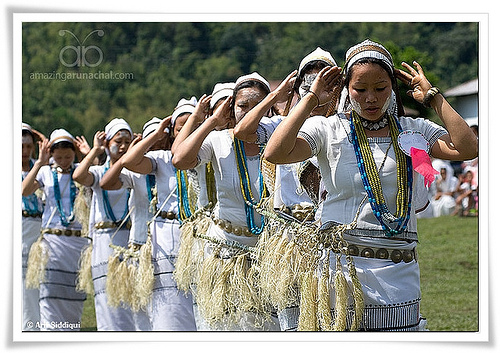
Attire
It is mainly performed by female members of the clan. These dancers wear pure white blouses and wrap skirts, that have red or maroon thread work on them. The use of bamboo is prevalent when it comes to accessories. A band of big coins is tied around the waist. Tufts of bamboo threads are tucked into this waistband. Long necklaces of multi-color beads are an important part of the attire. The faces are smeared with a white powder of rice flour. The heads are covered using a white cloth that hangs on the back. A special headgear made of bamboo is also used by some dancers. The headgear has bamboo tufts drooping from it. Heavy metal rings are worn in the ears.
Performance
Popir dance comprises of simple and elegant moves. The dancers make small movements with their feet. They also form a chain holding each other’s waist and then swing their feet in unison. A signature step involves holding a piece of equipment in their right hands and dancing with the body slightly bent forwards. These few steps are done in repetition.
For Better Retention: Watch: https://youtu.be/QtavZ0VDxFo
Bardo Chham literally translates to ‘Dance of the Zodiacs’. The people of the Sherdukpens community believe that there are twelve evils like twelve zodiacs, one for each month of the year. They appear over the course of the entire year in animal forms. Sherdukpens narrate this message through Bardo Chham dance during various regional festivities.
The Bardo Chham dance is performed both by both the men and women of the Sherdukpens community. They hold this dance very close to their heart. It is an act put up to depict the evils that mankind has to fight and defeat, symbolizing the victory of good over evil.
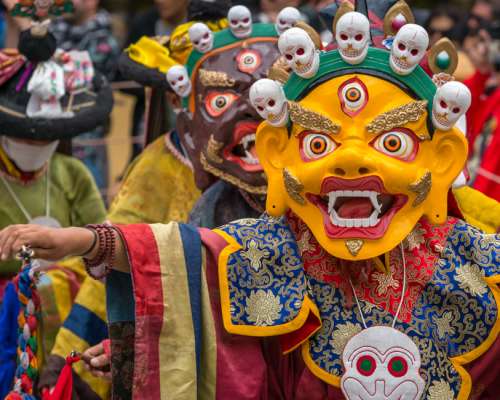
Costume
The masks and headgears worn by the performers are very important to the story being told and also to the overall appearance of the dance. The hand and head movements, combined with the bright costumes, make it a sight to behold.
The attire of the performers in this dance is very bright and colorful. The dancers also wear masks of different animal kinds to symbolize the evil spirits. The headgear worn by the dancers is quite elaborate as there is a lot of head movement involved in the act.
Instruments Used
The music for the dance is very crucial. It sets the whole ambiance of the performance and is played on large drums and cymbals.
For Better Retention: Watch: https://youtu.be/62NEcNTZQOg

Follow the following links to read about Folk Dances of other states:
https://www.iasgyan.in/blogs/statewise-list-of-folk-dances-of-india-andhra-pradesh
© 2025 iasgyan. All right reserved